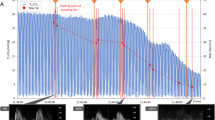Abstract
The influence of changes in systemic blood gas and pH values on the thromboembolic reaction following wall puncture was studied in rabbit mesenteric arterioles and venules (diameter 20–40 μm), using intravital videomicroscopy. Under normal circumstances the number of emboli produced was higher in arterioles than in venules (6 and 1, respectively). The initial thrombus growth, the number of emboli produced per vessel and the total duration of the embolisation period were not significantly influenced by changes in blood gas and pH values in both arterioles and venules. Therefore, the observed difference in thromboembolic reaction between arterioles and venules cannot be explained by differences in blood gas and pH values in these microvessels. Since reduced velocity, as a measure of wall shear rate, did not correlate with the thromboembolic reaction in arterioles or venules, fluid dynamics can also not explain the difference, indicating that the thrombogenic or anuthrombogenic activity of arteriolar and venular walls differs following injury. A combination of hypercapnia and hypoxia was found to result in a prolongation of the average time period needed to produce a new embolus in both vessel types. This prolongation in embolus production time was largely due to the occurrence of periods, in which the thrombus did not grow, reflecting hampering of the adhesion and aggregation of blood platelets to a growing thrombus under hypereapnic/hypoxic conditions.
Similar content being viewed by others
References
Born GVR, Cross MJ (1963) The aggregation of blood platelets. J Physiol (Lond) 168:178–195
Busse R, Förstermann U, Matsuda H, Pohl U (1984) The role of prostaglandins in the endothelium-mediated vasodilatory response to hypoxia. Pflügers Arch 401:77–83
Deussen A, Möser G, Schrader J (1986) Contribution of coronary endothelial cells to cardiac adenosine production. Pflügers Arch 406:608–614
Duling BR, Berne RM (1970) Longitudinal gradients in periarteriolar oxygen tension. Circ Res 27:669–678
Flatow FA, Freireich EJ (1966) The increased effectiveness of platelet concentrates prepared in acidified plasma. Blood 27:449–459
Gimbrone MA (1981) Vascular endothelium and atherosclerosis. In: Moore S (ed) Vascular injury and atherosclerosis. Dekker, New York, pp 25–52
Gimbrone MA (1986) Vascular endothelium: nature's blood container. In: Gimbrone MA (ed) Vascular endothelium in hemostasis and thrombosis. Churchill Livingstone, Edinburgh, pp 1–13
Goldschmidt B (1973) Effect of lactic acid on the aggregation of human platelets induced by ADP, adrenaline and collagen. Experientia 29:1399–1401
Han P, Ardlie NG (1974) The influence of pH, temperature, and calcium on platelet aggregation: maintenance of environmental pH and platelet function for in vitro studies in plasma stored at 37°C. Br J Haematol 26:373–389
Intaglietta M, Tompkins WR (1973) Microvascular measurements by video image shearing and splitting. Microvasc Res 5:309–312
Kennedy PS, Ware JA, Horak JK, Solis RT (1981) The effect of acute changes in arterial blood pH andpO2 on platelet aggregation. Microvasc Res 22:324–330
Kikugawa K, Iizuka K, Ichino M (1972) Effect of plasma pH on stability and capacity of aggregation of platelets. Chem Pharm Bull 20:1569–1571
Kozma C, Macklin W, Cummins LM, Mauer R (1974) Anatomy, physiology, and biochemistry of the rabbit. In: Weisbroth SH, Flatt RE, Kraus AL (eds) The biology of the laboratory rabbit. Academic Press, New York, pp 50–72
Lundgren O (1984) Microcirculation of the gastrointestinal tract and pancreas. In: Renkin EM, Michel CC (eds) Handbook of physiology, section 2, The cardiovascular system, vol. 4, Microcirculation. American Physiological Society, Bethesda, pp 799–863
Mehta J, Mehta P, Lawson DL, Ostrowski N, Brigmon L (1985) Influence of selective thromboxane synthetase blocker CGS-13080 on thromboxane and prostacyclin biosynthesis in whole blood: Evidence for synthesis of prostacyclin by leukocytes from platelet-derived endoperoxides. J Lab Clin Med 106:246–252
Moncada S (1982) Biological importance of prostacyclin. Br J Pharmacol 76:3–31
oude Egbrink MGA, Tangelder GJ, Slaaf DW, Reneman RS (1988) Thromboembolic reaction following wall puncture in arterioles and venules of the rabbit mesentery. Thromb Haemost 59:23–28
Rogers AB (1972) The effect of pH on human platelet aggregation induced by epinephrine and ADP. Proc Soc Exp Biol Med 139:1100–1103
Slaaf DW, Rood JPSM, Tangelder GJ, Jeurens TJM, Alewijnse R, Reneman RS, Arts T (1981) A bidirectional optical (BDO) three-stage prism grating system for on-line measurement of red blood cell velocity in microvessels. Microvasc Res 22:110–122
Slaaf DW, Alewijnse R, Wayland H (1982) Use of telescopic imaging in intravital microscopy: a simple solution for conventional microscopes. Int J Microcirc Clin Exp 1:121–134
Slaaf DW, Tangelder GJ, Reneman RS, Arts T (1986) Dual sensor model calculations applied to blood cell velocity profiles obtained by direct observation in vivo. Int J Microcirc Clin Exp 5:242
Tang SS, Frojmovic MM (1977) The effects ofpCO2 and pH on platelet shape change and aggregation for human and rabbit platelet-rich plasma. Thromb Res 10:135–145
Tangelder GJ, Slaaf DW, Muijtiens AMM, Arts T, oude Egbrink MGA, Reneman RS (1986) Velocity profiles of blood platelets and red blood cells flowing in arterioles of the rabbit mesentery. Circ Res 59:505–514
Vermijlen J, Arnout J, Deckmijn H, Xhonneux B, de Clerck F (1986) Continuous inhibition of the platelet S2-serotonergic receptors during the long term administration of ketanserin. Thromb Res 42:721–723
Author information
Authors and Affiliations
Rights and permissions
About this article
Cite this article
oude Egbrink, M.G.A., Tangelder, G.J., Slaaf, D.W. et al. Effect of blood gases and pH on thromboembolic reactions in rabbit mesenteric microvessels. Pflugers Arch. 414, 324–330 (1989). https://doi.org/10.1007/BF00584634
Received:
Revised:
Accepted:
Issue Date:
DOI: https://doi.org/10.1007/BF00584634




